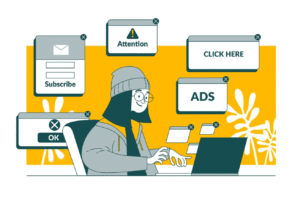How Does Programmatic Advertising Work? A Complete Guide

Digital advertising has experienced big changes in recent years. Traditional advertising depended on human negotiation and manual placement. Nowadays, the entire scene is full of programmatic advertising. And it’s fast, efficient, and extremely precisely targeted–but to those new to the concept, it can seem a bit intimidating
What Is Programmatic Advertising?
In essence, programmatic advertising means automating the buying and selling of digital ad space. Programmatic advertising uses real-time bidding systems and algorithms to prompt advertisers into buying advertisements as they become available and at reasonable costs.
It’s simply a better way to get your message across, sticking ads into the channels that your particular audience is already watching or listening to at exactlywhen they are going through it.
What’s more, while not only automating a process for saving t he time of publishers and brokers, it also opens the door to new possibilities with a wealth of data about buyer behavior— data that canhelp advertisers tightly target their campaigns.
Key Components of Programmatic Advertising
The process might sound complex, but understanding the key components of programmatic advertising can make it easier to grasp.
- Demand-Side Platform (DSP)
A DSP is software used by advertisers to purchase ad impressions in real time. It uses algorithms to decide where and when to place advertisements based on specific targeting criteria (e.g., user demographics, browsing habits).
- Supply-Side Platform (SSP)
On the flip side, publishers use SSPs to make their ad inventory available for sale. SSPs help maximize revenue by ensuring premium prices for ad space via RTB.
- Ad Exchange
Think of this as a marketplace where buyers (advertisers using DSPs) and sellers (publishers using SSPs) meet to trade ad impressions.
- Ad Inventory
This refers to the digital real estate that publishers offer for ads, including website banners, video pre-roll slots, and social media placements.
- Data Management Platform (DMP)
DMPs collect and analyze data about user behavior, helping advertisers target and optimize their campaigns. It ensures the ads are shown to the right audience.
How Programmatic Advertising Works
Now that you know the basic components, here’s how the process works step-by-step.
Step 1: Setting the Campaign Goals
Before launching a campaign, advertisers define their target audience and campaign objectives. For example, a clothing brand may want to target young adults aged 18–25 who are interested in fashion and lifestyle.
Step 2: Targeting & Data Collection
Advertisers set detailed targeting parameters based on demographics, location, interests, or online behaviors. The DMP gathers and processes audience data, ensuring the ads hit the mark.
Step 3: Real-Time Bidding
When you visit a website, it takes mere milliseconds for bidding to occur. Here’s what happens behind the scenes:
- A publisher’s SSP sends an ad request to the ad exchange.
- The ad exchange alerts various DSPs, providing details about the viewer (e.g., their location and browsing habits).
- DSPs bid on behalf of advertisers in an auction. Whoever offers the highest bid wins the ad placement.
Step 4: Ad Delivery
The winning ad is displayed to the viewer on the website or platform, all in the blink of an eye.
Step 5: Continuous Optimization
Once the campaign is live, programmatic systems continuously monitor performance and make adjustments. If an ad isn’t performing as expected, the DSP may redirect spend to higher-performing placements automatically.
Why Is Programmatic Advertising Effective?
Programmatic advertising has become a favorite tool among marketers for several reasons.
1. Precision Targeting
Unlike traditional media buys, programmatic ads enable advertisers to laser-focus on their desired audience. Whether it’s by age, location, income level, or even recent Google search history, the targeting capabilities are unmatched.
2. Cost Efficiency
Since advertisers only pay for placements that reach their designated audience, there’s far less waste compared to traditional methods. This ensures maximum return on investment (ROI).
3. Real-Time Data Insights
Programmatic platforms offer advanced analytics, such as impression data, click-through rates (CTR), and conversion rates. Advertisers can adjust their strategies on the fly, improving campaign performance.
4. Automated & Scalable
The process is faster and more scalable than manual ad buying, enabling brands to launch campaigns across multiple platforms at once.
5. Dynamic Ad Delivery
Programmatic systems allow for dynamic creative optimization (DCO), meaning ads can automatically adjust their content based on the viewer’s preferences or behavior.
Where Can You Use Programmatic Advertising?
One of the greatest strengths of programmatic advertising is its versatility. Here are some common channels where it’s used:
- Display Ads: Banner ads on websites or mobile apps.
- Video Ads: Pre-roll or mid-roll ads on platforms like YouTube.
- Social Media: Ads on networks like Instagram, Facebook, and LinkedIn.
- Native Ads: Content that blends seamlessly into the surrounding content, such as sponsored articles or in-feed ad units.
- Audio Ads: Programmatic ads on platforms like Spotify or podcast networks.
- CTV/OTT: Ads on streaming platforms like Hulu and Roku.
Challenges of Programmatic Advertising
While this method offers significant advantages, it’s not without its hurdles. Businesses need to be aware of:
- Ad Fraud
Programmatic can sometimes lead to low-quality or fraudulent traffic, costing advertisers money. Using tools like fraud detection software can help mitigate this risk.
- Data Privacy Concerns
With regulations such as GDPR and CCPA, advertisers must ensure compliance with data privacy laws when collecting and utilizing user data.
- Complex Technology
For those new to programmatic, the ecosystem can feel overwhelming. Partnering with experienced vendors or agencies may be necessary to manage campaigns effectively.
How to Get Started with Programmatic Advertising
If you’re considering tapping into the power of programmatic advertising, follow these steps to get started:
- Partner with a Trusted Platform
Choose a reliable DSP or ad exchange that aligns with your budget and goals. Platforms like Google Ads, Amazon DSP, and The Trade Desk are popular options.
- Analyze Your Audience
Use a DMP to gather as much data on your target audience as possible. The more you understand your customers, the better you can target them.
- Set Clear Objectives
Define what success looks like for your campaign, whether that’s brand awareness, lead generation, or increased sales.
- Monitor & Optimize
Track your campaign’s metrics closely and make adjustments as needed for continuous improvement.
Reimagine Digital Marketing with Smarter Ad Placements
Programmatic advertising has changed the way companies run their online marketing campaigns, for example using automation and accurate targeting to get more out of the advertising budget. Communication tools are a necessity—whether you’re a small agency or global company–to help keep up with the rapid advance in digital marketing. Move into this sector now and take your advertising up to an all-time high!






